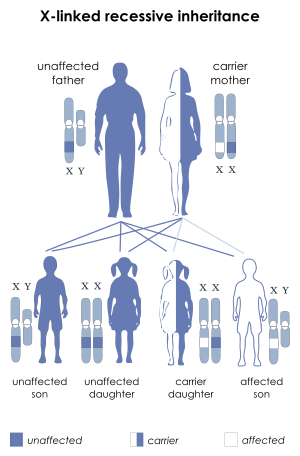X-linked myotubular myopathy
X-linked myotubular myopathy (MTM) is a form of centronuclear myopathy (CNM) associated with myotubularin 1.
| X-linked myotubular myopathy | |
|---|---|
| Other names | XLMTM |
 | |
| This condition is inherited in an X-linked recessive manner. | |
Genetically inherited traits and conditions are often referred to based upon whether they are located on the "sex chromosomes" (the X or Y chromosomes) versus whether they are located on "autosomal" chromosomes (chromosomes other than the X or Y). Thus, genetically inherited conditions are categorized as being sex-linked (e.g., X-linked) or autosomal. Females have two X-chromosomes, while males only have a single X chromosome, and a genetic abnormality located on the X chromosome is much more likely to cause clinical disease in a male (who lacks the possibility of having the normal gene present on any other chromosome) than in a female (who is able to compensate for the one abnormal X chromosome).
The X-linked form of MTM is the most commonly diagnosed type. Almost all cases of X-linked MTM occurs in males. Females can be "carriers" for an X-linked genetic abnormality, but usually they will not be clinically affected themselves. Two exceptions for a female with a X-linked recessive abnormality to have clinical symptoms: one is a manifesting carrier and the other is X-inactivation. A manifesting carrier usually has no noticeable problems at birth; symptoms show up later in life. In X-inactivation, the female (who would otherwise be a carrier, without any symptoms), actually presents with full-blown X-linked MTM. Thus, she congenitally presents (is born with) MTM.[1] Thus, although MTM1 mutations most commonly cause problems in boys, these mutations can also cause clinical myopathy in girls, for the reasons noted above. Girls with myopathy and a muscle biopsy showing a centronuclear pattern should be tested for MTM1 mutations.[1]
Presentation
This condition is found almost always in male infants. It is one of the severest congenital muscle diseases and is characterized by marked muscle weakness, hypotonia and feeding and breathing difficulties.
Genetics
This condition is caused by mutations in the myotubularin (MTM1) gene which is located on the long arm of the X chromosome (Xq28).
Many clinicians and researchers use the abbreviations XL-MTM, XLMTM or X-MTM to emphasize that the genetic abnormality for myotubular myopathy (MTM) is X-linked (XL), having been identified as occurring on the X chromosome. The specific gene on the X chromosome is referred to as MTM-1. In theory, some cases of CNM may be caused by an abnormality on the X chromosome, but located at a different site from the gene MTM1, but currently MTM1 is the only X-linked genetic mutation site identified for myotubular or centronuclear myopathy. Clinical suspicion for X-linked inheritance would be a disease affecting multiple boys (but no girls) and a pedigree chart showing inheritance only through the maternal (mother’s) side of each generation.
Gene therapy
Audentes Therapeutics is developing an experimental gene therapy to treat the condition. A clinical trial was halted in 2020 after two boys participating in the trial died of liver inflammation and sepsis.[2]
References
- Jungbluth H, Sewry C, Buj-Bello A, Kristiansen M, Ørstavik K, Kelsey A, Manzur A, Mercuri E, Wallgren-Pettersson C, Muntoni F (2003). "Early and severe presentation of X-linked myotubular myopathy in a girl with skewed X-inactivation". Neuromuscul Disord. 13 (1): 55–9. doi:10.1016/S0960-8966(02)00194-3. PMID 12467733.
- Anonymous (2020). "Two boys die in gene therapy trial". Science. 369 (6499): 13.
External links
| Classification | |
|---|---|
| External resources |